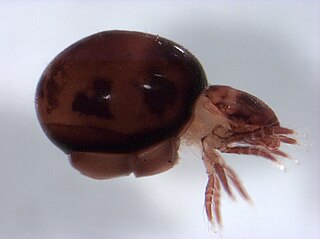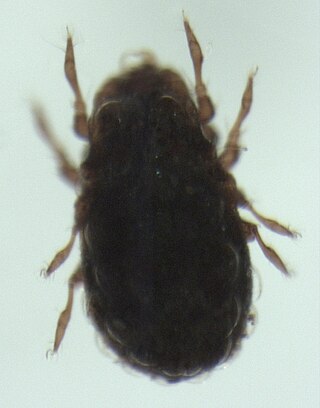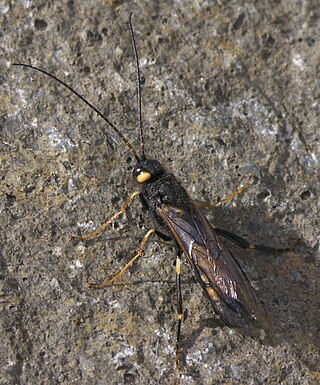
The Acaridae are a family of mites in order Sarcoptiformes.

Oribatida, also known as oribatid mites, moss mites or beetle mites, are an order of mites, in the "chewing Acariformes" clade Sarcoptiformes. They range in size from 0.2 to 1.4 millimetres. There are currently 12,000 species that have been identified, but researchers estimate that there may be anywhere from 60,000 to 120,000 total species. Oribatid mites are by far the most prevalent of all arthropods in forest soils, and are essential for breaking down organic detritus and distributing fungi.

Brachypylina is a group of oribatid mites, variously listed as a suborder, infraorder, or a cohort.

Histiostomatidae is a family of mites in the clade Astigmata.
Austrophthiracarus is a genus of mites in the family Steganacaridae.
Pelzneria is a genus of mites in the family Acaridae. Species of Pelzneria are most often associated with small vertebrate carrion, and most species are phoretic on silphid beetles of the genus Nicrophorus.

Carabodidae is a family of oribatids in the order Oribatida. There are at least 20 genera and 300 described species in Carabodidae.

Winterschmidtiidae is a family of mites in the order Astigmata.
Mochlozetidae is a family of mites and ticks in the order Sarcoptiformes. There are about 12 genera and at least 50 described species in Mochlozetidae.

Urocerus is a genus of horntails in the family Siricidae. There are about eight described species in Urocerus.
Polystepha is a genus of gall midges in the family Cecidomyiidae. There are more than 20 described species in Polystepha.

Hypochthonius is a genus of mites in the family Hypochthoniidae. There are about 10 described species in Hypochthonius.

Enarthronota is a suborder of mites in the order Oribatida. There are about 14 families and more than 450 described species in Enarthronota.
Gozmanyina is a genus of cosmochthoniids in the family Cosmochthoniidae. There are at least three described species in Gozmanyina.

Oripodoidea is a superfamily of oribatids in the order Oribatida. There are about 19 families and at least 1,300 described species in Oripodoidea.

Scolopostethus is a genus of dirt-colored seed bugs in the family Rhyparochromidae. There are more than 30 described species in Scolopostethus.
Eudicrana is a genus of fungus gnats in the family Mycetophilidae. There are about 13 described species in Eudicrana.

Asteromyia is a genus of gall midges in the family Cecidomyiidae. There are about nine described species in Asteromyia.
Exochocepheus is a genus of mites in the family Scutoverticidae. There are about seven described species in Exochocepheus.

Galumna is a genus of mites in the family Galumnidae.










